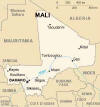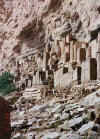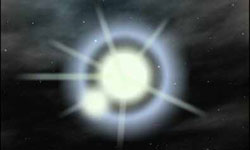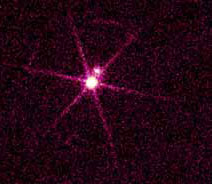|


The Dogon are an
ethnic group located mainly in the administrative districts of Bandiagara
and Douentza in Mali, West Africa.
The precise origin of the Dogon, like those of many other
ancient cultures, is undetermined. Their civilization just emerged, in much
the same manner as ancient Sumer and Ancient Egypt.
The early histories are informed by oral traditions that differ according to
the Dogon clan being consulted and archaeological excavation
much more of which needs to be conducted.
Because of these inexact and incomplete sources, there are a number of
different versions of the Dogon's origin myths as well as
differing accounts of how they got from their ancestral homelands to the
Bandiagara region. The people call themselves 'Dogon' or
'Dogom', but in the older literature they are most often called
'Habe', a Fulbe word meaning
'stranger' or 'pagan'.
Certain theories suggest the tribe to be of ancient Egyptian descent. They
next migrated to Libya, then somewhere in the regions of Guinea or
Mauritania. Around 1490 AD, fleeing invaders and/or drought, they migrated
to the Bandiagara cliffs of central Mali.
Carbon-14 dating techniques used on excavated remains found in the cliffs
indicate that there were inhabitants in the region before the arrival of
the Dogon. They were the Toloy culture of the 3rd
to 2nd centuries BC, and
the Tellem culture of the 11th to 15th centuries AD.
The religious beliefs of the Dogon are enormously complex and
knowledge of them varies greatly within Dogon society. Dogon religion
is defined primarily through the worship of the ancestors and the spirits
whom they encountered as they slowly migrated from their obscure ancestral
homelands to the Bandiagara cliffs.
There are three principal cults among the Dogon;
-
The Awa is a cult of the dead, whose purpose is to reorder the
spiritual forces disturbed by the death of Nommo, a
mythological ancestor of great importance to the Dogon.
|
Members of the Awa cult dance with ornate carved and painted
masks during both funeral and death anniversary ceremonies. There are 78
different types of ritual masks among the Dogon and their
iconographic messages go beyond the aesthetic, into the realm of religion
and philosophy. |
 |
The primary purpose of Awa dance ceremonies is to lead souls
of the deceased to their final resting place in the family altars and to
consecrate their passage to the ranks of the ancestors.
-
The cult of Lebe, the Earth God, is primarily concerned with
the agricultural cycle and its chief priest is called a Hogon.
|
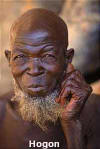 |
All Dogon villages have a Lebe shrine whose altars have bits
of earth incorporated into them to encourage the continued fertility of the
land.
According to Dogon beliefs, the god Lebe
visits the
hogons every night in the form of a serpent
and licks their skins in order to purify them and infuse them with life
force.
The hogons are responsible for guarding the purity
of the soil and therefore officiate at many agricultural ceremonies. |
Nowadays, the Dogon blacksmiths forge mainly scrap metal
recuperated from old railway lines or car wrecks. So, little by little, the
long process of iron ore reduction, which demands a perfect knowledge of
fire and its temperatures, has been abandoned.
|
One of the last smelting was done in Mali, in 1995, by the Dogon
blacksmiths. The event became the subject of a film which was
entitled 'Inagina, The Last House of Iron'. Eleven blacksmiths, who
still hold the secrets of this ancestral activity, agreed to perform
a last smelt. They gathered to invoke the spirits.
They sunk a mine shaft, made charcoal, and built a furnace with earth and
lumps of slag. The last furnace - or Inagina - meaning
literally the
'house of iron' gave birth to 69 kilos of
iron of excellent quality.
|
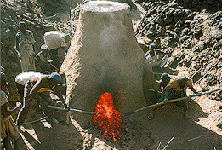 |
With this, the blacksmiths forged traditional tools intended for
agriculture, the making of weapons, and jewelry for the Dogon people.
Youdiou Dances - During the Dama celebration, Youdiou villagers circle
around two stilt dancers. The dance and costumes imitate the tingetange, a
long-legged water bird. The dancers execute difficult steps while teetering
high above the crowd.
-
The cult of Binu is a totemic practice and it has complex
associations with the Dogon's sacred places used for ancestor
worship, spirit communication and agricultural sacrifices. Marcel Griaule
and his colleagues came to believe that all the major Dogon sacred
sites were related to episodes in the Dogon myth of the
creation of the world, in particular to a deity named
Nommo.
Binu shrines house spirits of mythic ancestors who lived in
the legendary era before the appearance of death among mankind. Binu
spirits often make themselves known to their descendants in the form
of an animal that interceded on behalf of the clan during its founding or
migration, thus becoming the clan's totem.
The priests of each Binu maintain the sanctuaries whose
facades are often painted with graphic signs and mystic symbols. Sacrifices
of blood and millet porridge the primary crop of the Dogon are
made at the
Binu shrines
at sowing time and whenever the intercession of the immortal ancestor is
desired.
Through such rituals, the Dogon believe that the benevolent
force of the ancestor is transmitted to them.
|
 |
Kananga masks form geometric patterns and
represent the first human beings. The Dogon believe that the
Dama dance creates a bridge into the supernatural world. Without the
Dama dance, the dead cannot cross over into peace. |
Their self-defense comes from their social solidarity which is based on a
complex combination of philosophic and religious dogmas, the
fundamental law being the worship of ancestors. Ritual masks and corpses are
used for ceremonies and are kept in caves. The Dogons are both
Muslims and Animists.
|
A 'Togu Na' - 'House of Words' -
stands in
every Dogon village and marks the male social
center. The low ceiling, supported by carved or sculptured posts, prevents
over zealous discussions from escalating into fights. Symbolic meaning
surrounds the Togu Na.
On the Gondo Plain, Togu Na pillars are carved out of Kile wood
and often express themes of fertility and procreation. Many of the carvings
are of women's breasts, for as a Dogon proverb says, "The breast is second
only to God." |
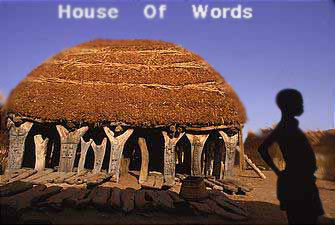 |
Unfortunately, collectors have stolen some of the more intricately carved
pillars, forcing village elders to deface their Togu Na posts
by chopping off part of the sculpted wood. This mutilation of the sculpted
pillars assures their safety.
|
 |
 |
Amaguime Dolu, a diviner in the village of Bongo,
performs a ritual. He derives meaning and makes predictions from grids and
symbols in the sand. At dusk, he draws a questions in the sand for the
sacred fox to answer. The
Dogon people believe the fox has supernatural powers.
|
The Dogon may ask questions such as: "Does the man I love also
love me?" or "Should I take the job offer at the mission church?"
In the morning, the diviner will read the fox prints on the sand and make
interpretations. The fox is sure to come because offerings of millet, milk
and peanuts are made to this sacred animal.
The Washington Post
Robert Temple
The Sirius Mystery


According to Dogon mythology, Nommo was the
first living being created
by Amma, the sky god and creator of the universe.
|
He soon multiplied to become six pairs of twins. [This is a metaphor for
our original 12-strand DNA. Our present physical DNA contains 2 strands
which hold the genetic codes for our physical evolvement.]
One twin rebelled against the order established by Amma, [This is
a metaphor for one source/soul splitting into two polarities - yin /yang,
when it enters into the electro-magnectic energies of third dimension]
thereby destabilizing the universe. In order to purify the cosmos and
restore its order, Amma sacrificed another of the Nommo,
whose body was cut up and scattered throughout the universe. This
distribution of the parts of the Nommo's body
is seen as the source for the proliferation of Binu shrines
throughout the Dogon region. |
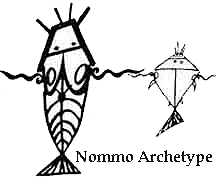 |
The Dogon say that their astronomical knowledge was given to
them by
the Nommo. The Dogon elder, Ogotemelli, describes them
variously as having the upper part as a man and the lower portion as
snake; or as having a ram's head with serpent body.
Author Robert Temple describes the Nommo as
amphibious beings sent to Earth from the Sirius star system
for the benefit of humankind. They look like
Merfolk; Mermaids and Mermen. [Metaphor:
amphibius - referring to the flow of the collective unconscious - creational
source].
|
 |
After the landing in a space ship, something with four legs
appeared and dragged the vessel to a hollow, which filled with water until
the vessel floated in it. The Dogon, call this spaceship
'Pelu Tolo' or
'Star of the Tenth Moon'.
These aliens supposedly came from the Sirian star system.
Their spaceship spiraled down from the sky. It landed somewhere to the
northeast of the
Dogon's present homeland. |
There was a great noise and wind. The ship landed on three legs, skidded to
a stop, scoring the ground. Four legs appeared and dragged the vessel to a
hollow, which filled with water until the vessel floated.
At the same time a new star was seen in the sky, which possibly was a large
space ship. The star was described by the Dogon as having a
circle of reddish rays around it. This circle of rays was like a spreading
spot yet it still remaining the same size.
There is a Dogon drawing of the spaceship hovering in the
sky, waiting for
the Nommo who landed on the Earth. It represents three stages
of 'Pelu Tolo'
when it is spurting different amounts of blood or flames [as if
it crash landed].
They called the Nommo 'Masters of the Water', 'The Monitors',
'The Teachers or Instructors', 'Saviors', and 'Spiritual Guardians'.
The Dogons believe their gods are already here.


By
Ellie
The Dogons have a unique distinction. Supposedly when they
left Egypt and migrated to Mali where they brought with them sacred
knowledge in the form of oral traditions - perhaps handed down by the
ancient priests of Egypt. There are oral tradition about interaction with
Amphibious Gods who came to Earth from the star Sirius
(now called Sirius A).
Dogon astronomical lore goes back at least 5000 years. This
knowledge most likely dates back to the time of the ancient Egyptian priests
- who stored their knowledge as their civilization was destroyed. This
knowledge was too be part of our collective unconsciousness - to be
remembered - to be brought to the public - when it was time for humanity to
make great changes. These changes are reflected in all ancient prophecies.
The information is about creation by Geometry - Mathematical patterns or
formulas. We sense change in our thinking and our souls. We dream unusual
dreams about changes and look for Magic in our lives, movies, books, TV
shows. We experience beyond third dimension.
The souls of children, teens and young adults are often called Indigo
Children - Children of the Blue Ray sense this. They
are telekinetic sometimes moving objects - or bending objects with their
minds.
This collective unconscious is a program of grids. The
Dogon draw grids.
They understand the nature of our reality, based on an electromagnetic grid
program that stores memory - The Matrix is the grids.
Following the pattern of the grids...... Dogon legend came
with them from Egypt based on the ancient religions and the mystery
school teachings of
Isis and Osiris. It all begins in the area that was
Sumer - The Cradle of Civilization - but in truth the area that
surround the Great Pyramid. The Egyptian Goddess Isis
is identified by the Egyptians with the
star Sirius.
The Dogons knew about Sirius long before modern man discovered
the star system. Their religious tradition, dating back to their Egyptian
roots, was later imparted through Greek migratory patterns. The name
Sirius was given by the ancient Greeks.
|
Planet Earth has many metaphors, archetypes and symbols that help us
understand the nature of our creation. To this end we study the heavens and
celestial blueprints and the physical planet, to unravel secrets buried
until it was time.....
In the late 1930s, four Dogon priests shared their most
important secret tradition with two French anthropologists, Marcel
Griaule and Germain Dieterlen after they had spent an
apprenticeship of fifteen years living with the tribe.
These were secret myths about the star Sirius,
which is 8.6 light years from the Earth. |
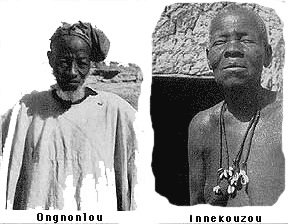 |
The priests said that Sirius had a companion star that was
invisible to the human eye. They also stated that:
-
the star moved in a 50-year elliptical orbit around Sirius,
-
that it was small and incredibly heavy,
-
and that it rotated on its axis.
Initially the anthropologists wrote it off publishing the information in an
obscure anthropological journal, because they didn't appreciate the
astronomical importance of the information.
What they didn't know was that since 1844, astronomers had suspected that
Sirius A had a companion star. This was in part determined
when it was observed that the path of the star wobbled. In 1862 Alvan
Clark discovered the second star making Sirius a binary star
system (two stars).
In the 1920's it was determined that Sirius B, the companion
of Sirius, was a white dwarf star. White dwarfs are small, dense stars that
burn dimly. The pull of its gravity causes Sirius' wavy movement.
Sirius B is smaller than planet Earth.
The Dogon name for Sirius B is Po Tolo. It means
star - tolo and smallest seed - po. Seed refers to creation. In this case -
human creation.
By this name they describe the star's smallness. It is, they say,
the smallest thing there is. They also claim that it is the heaviest
star and is white in color. The Dogon thus attribute to Sirius B
its three principal properties as a
white dwarf: small, heavy, white.
|
The earliest Egyptians believed Sirius - 'Sothis' - was the
home of souls that have crossed over. This belief is also shared with
the Dogon.
Creation is linked to the Great Pyramid which links to
Orion in the
Kings Chamber (male) and to Sirius
in the
Queens Chamber (female), Isis. |
 |
Not far from the Pleaides, The Seven Sisters, the sky
is like a big giant map of messages, a blueprint, if you will, of creational
patterns. Ancient civilizations named the planets and created myths about
them, all linked to the heavens and gods who created humans and came to
Earth from the sky.
Isis and Osiris, Zeus and Hera, Amma and his
female counterpart. He had to have one as this matrix and grid is all based
on opposites - polarities - like a magnetic (north and south).
The Star of Isis is called Sothis, or Sirius
and is the brightest star in our night sky. The Dogon also
describe this 'star' specifically as having a circle of reddish rays around
it, and this circle of rays is 'like a spot spreading' but remaining the
same size.
|
The Dogons have described perfectly the DNA pattern
made by this elliptical orbit created by the two stars as they rotate make
around each other. They believe Sirius to be the axis of the
universe, and from it all matter and all souls are produced in a great
spiral motion.
The Dogon also claimed that a third star Emme Ya
- sorghum female - exists in the Sirius system. Larger and
lighter than Sirius B, this star revolves around Sirius
A as well. It has not been proven to exist, though some people have
called it Sirius C. |
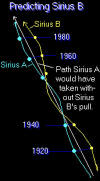 |
Sirius C translated from the Dogon language into
English is called the
"Sun of Women". It is described by the Dogon as
"the seat of the female souls of living or future beings". Its
symbol contains two pair of lines that are relevant features of a
Dogon legend. The Dogon believe that
Sirius C sends out two pairs of beams and that the beams
represent a feminine figure.
Some of the ancient Egyptian temples, such as the Temple
of Isis at Denderah,
were created so that the light of the helical rising of Sirius would travel
down the main corridor to place its red glow upon the altar in the inner
sanctum of the temple. When that light reached the altar, the beam of light
from Sirius was transformed into Sothis, the Star Goddess,
Isis.
In a manner of speaking, the same belief system was involved in the
Greek Temples, such as the Parthenon, which were oriented to receive
the beams of light from the Pleiades into their inner
sanctums, where the beams were then transformed into seven women. As the
beams from the Pleiades entered the
Egyptian temple of Hathor it became the seven Hathors female
judges of mankind.
Within the Dogon tradition, those pairs of feminine figures
beamed down from the Star/Sun/Planet of Women to their original home near
the Hoggar mountains bringing many aspects of civilization to
the ancestors of their tribes.
Dogon oral traditions state that for thousands of years they
have known that the Earth revolves around the Sun, that Jupiter's has moons
and that Saturn's has rings.
The Dogons calendar is quite non-traditional in that its fifty
year cycle is based neither on the Earth's rotation around the Sun (as is
our Julian calendar) nor the cycles of the Moon (a lunar calendar). Instead,
the Dogon culture centers around the rotation cycle
Sirius B which encircles the primary star Sirius A
every 49.9 - or 50 years.

|
